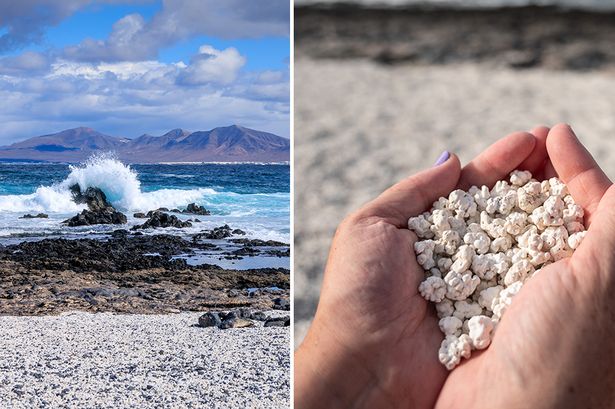Ever dreamt of walking on a beach resembling popcorn? A European shore on the Canary Islands has a striking natural phenomenon that is well worth a visit for some winter sun
With temperatures plummeting in the UK, holidaymakers are turning their attention to European winter getaways to bask in a warmer climate, and there’s one fascinating place with a ‘popcorn beach’ that reaches a welcoming 24C in November.
The Canary Islands, known as the sunshine centre of Europe, have long been top of the list for Brits hunting for some sun, with beaches offering golden sand and crystal clear blue waters. But it’s not just the picture-perfect coastlines that entice tourists to the southern region of Spain.
Elsewhere on the islands, visitors can stumble upon beaches with shimmering or dark sand, due to the islands’ volcanic origin, or admire the sand dunes in Gran Canaria that resemble those in the Egyptian desert. With a fascinating collection of shores, there’s one that has caught attention, so much so that it’s been given its own nickname.
Popcorn Beach, officially called Playa del Bajo de la Burra, is one of the most striking beaches in the world. Found in Fuerteventura, the beach is fantastically composed of white, fossilised coral or calcareous algae that has been washed up on the shore, resembling puffed-up popcorn pieces.
The similarity to edible popcorn on the beach is so striking that in photos, it could easily be mistaken for the tasty cinema snack. Holidaymakers have flocked to the beach to marvel at the natural wonder, labelling it the “most bizarre in the world” and comparing it to the likes of the Caribbean.
One traveller shared a review of Popcorn Beach on TripAdvisor and said: “Great place to visit and just sit and relax. Nice wind and when the tide is out, plenty of rock pools to explore. Beware of the slippery lava rocks, very dangerous. When the tide is in, the white popcorn algae makes it look like the Caribbean!”
A second holidaymaker commented: “This a brilliant little beach near Corralejo Town, the bits of stoned algae that look like pop corn allow for brilliant photos. We visited with our toddler and filled in a nice half hour.”
“Unusual beach that truly looks like popcorn. Very nice views. Beach itself is a bit small,” a third shared. While another warned that you can’t swim in the sea, “Unfortunately, there is no direct water access on site, but the experience of Popcorn beach belongs on every adventure list on Fuerteventura.”
However, anyone planning to visit Popcorn Beach should be aware that there is a strict law against taking any of the coral home, no matter how tempting it might be as a souvenir. Unfortunately, it’s such a problem that the beach reportedly loses around 1,000kg of natural material per month.
Tourists have been urged to preserve the endangered ecosystems and refrain from removing any of their precious sand in the Canary Islands. Otherwise, visitors can face a fine of £128 (€150) to £512 (€600) for “minor” offences, or up to £2,563 (€3,000) for “major” breaches, depending on the amount pocketed, according to the Canarian Weekly.
Despite the strict laws, visitors are welcome to capture themselves among the popcorn-shaped coral in photos and stroll along the shore to admire its distinctive beauty. It’s well worth a visit to admire the natural phenomenon, and with temperatures in Fuerteventura reaching between 22 to 24C in November, it’s the ideal spot to bask in some sunshine.
Not only this, but the island is incredibly easy to reach with direct return flights from London Stansted to Fuerteventura, starting from as little as £36.99 with Ryanair.
Do you have a travel story to share? Email webtravel@reachplc.com
